engine coolant CADILLAC CTS V 2006 1.G Owners Manual
[x] Cancel search | Manufacturer: CADILLAC, Model Year: 2006, Model line: CTS V, Model: CADILLAC CTS V 2006 1.GPages: 442, PDF Size: 2.57 MB
Page 77 of 442
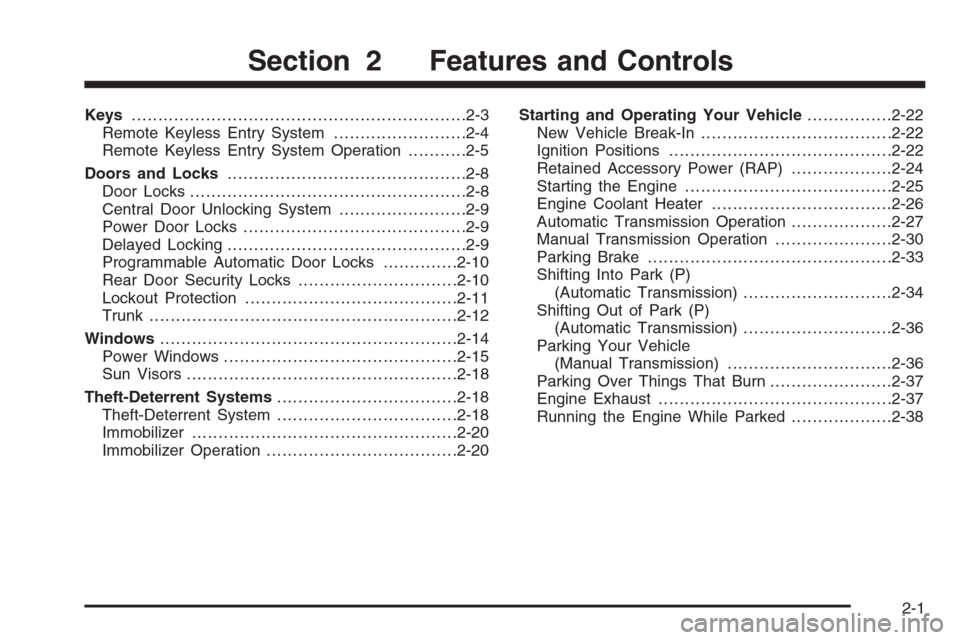
Keys...............................................................2-3
Remote Keyless Entry System.........................2-4
Remote Keyless Entry System Operation...........2-5
Doors and Locks.............................................2-8
Door Locks....................................................2-8
Central Door Unlocking System........................2-9
Power Door Locks..........................................2-9
Delayed Locking.............................................2-9
Programmable Automatic Door Locks..............2-10
Rear Door Security Locks..............................2-10
Lockout Protection........................................2-11
Trunk..........................................................2-12
Windows........................................................2-14
Power Windows............................................2-15
Sun Visors...................................................2-18
Theft-Deterrent Systems..................................2-18
Theft-Deterrent System..................................2-18
Immobilizer..................................................2-20
Immobilizer Operation....................................2-20Starting and Operating Your Vehicle................2-22
New Vehicle Break-In....................................2-22
Ignition Positions..........................................2-22
Retained Accessory Power (RAP)...................2-24
Starting the Engine.......................................2-25
Engine Coolant Heater..................................2-26
Automatic Transmission Operation...................2-27
Manual Transmission Operation......................2-30
Parking Brake..............................................2-33
Shifting Into Park (P)
(Automatic Transmission)............................2-34
Shifting Out of Park (P)
(Automatic Transmission)............................2-36
Parking Your Vehicle
(Manual Transmission)...............................2-36
Parking Over Things That Burn.......................2-37
Engine Exhaust............................................2-37
Running the Engine While Parked...................2-38
Section 2 Features and Controls
2-1
Page 102 of 442
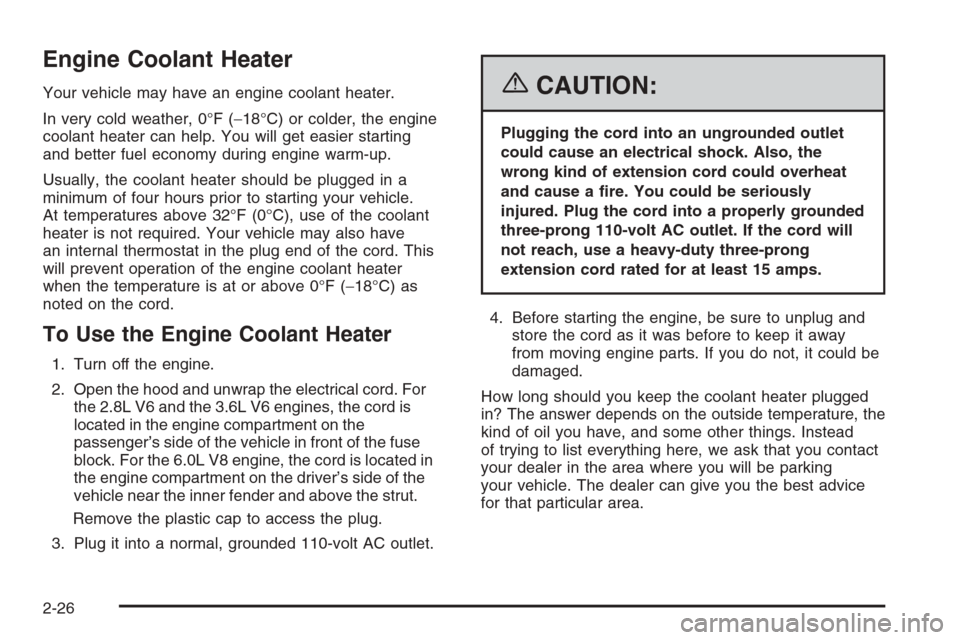
Engine Coolant Heater
Your vehicle may have an engine coolant heater.
In very cold weather, 0°F (−18°C) or colder, the engine
coolant heater can help. You will get easier starting
and better fuel economy during engine warm-up.
Usually, the coolant heater should be plugged in a
minimum of four hours prior to starting your vehicle.
At temperatures above 32°F (0°C), use of the coolant
heater is not required. Your vehicle may also have
an internal thermostat in the plug end of the cord. This
will prevent operation of the engine coolant heater
when the temperature is at or above 0°F (−18°C) as
noted on the cord.
To Use the Engine Coolant Heater
1. Turn off the engine.
2. Open the hood and unwrap the electrical cord. For
the 2.8L V6 and the 3.6L V6 engines, the cord is
located in the engine compartment on the
passenger’s side of the vehicle in front of the fuse
block. For the 6.0L V8 engine, the cord is located in
the engine compartment on the driver’s side of the
vehicle near the inner fender and above the strut.
Remove the plastic cap to access the plug.
3. Plug it into a normal, grounded 110-volt AC outlet.
{CAUTION:
Plugging the cord into an ungrounded outlet
could cause an electrical shock. Also, the
wrong kind of extension cord could overheat
and cause a �re. You could be seriously
injured. Plug the cord into a properly grounded
three-prong 110-volt AC outlet. If the cord will
not reach, use a heavy-duty three-prong
extension cord rated for at least 15 amps.
4. Before starting the engine, be sure to unplug and
store the cord as it was before to keep it away
from moving engine parts. If you do not, it could be
damaged.
How long should you keep the coolant heater plugged
in? The answer depends on the outside temperature, the
kind of oil you have, and some other things. Instead
of trying to list everything here, we ask that you contact
your dealer in the area where you will be parking
your vehicle. The dealer can give you the best advice
for that particular area.
2-26
Page 108 of 442

Shift Speeds (Manual Transmission)
{CAUTION:
If you skip a gear when you downshift, you
could lose control of your vehicle. You could
injure yourself or others. Do not shift down
more than one gear at a time when you
downshift.
Notice:If you skip more than one gear when you
downshift, or if you race the engine when you
release the clutch pedal while downshifting, you
could damage the engine, clutch, driveshaft or the
transmission. Do not skip gears or race the
engine when downshifting.
If the vehicle speed drops below 20 mph (32 km/h), or if
the engine is not running smoothly, you should
downshift to the next lower gear. You may have to
downshift two or more gears to keep the engine running
smoothly or for good performance.
Skip Shift (CTS-V)
1r4:This may appear in the message center in the
speedometer during light throttle, low speed maneuvers
(15 to 19 mph (24 to 31 km/h)). When this message
appears, you can only shift from FIRST (1) to
FOURTH (4) instead of FIRST (1) to SECOND (2).
SeeOne-to-Four Shift Message on page 3-52for more
information.
During the shift from FIRST (1) to FOURTH (4), pull the
shift lever straight back using light force on the shift
lever. You must complete the shift into FOURTH (4) to
turn off this feature. This helps you get the best
possible fuel economy. The skip shift feature is turned
backed on when the vehicle is at a complete stop.
Notice:Forcing the shift lever into any gear except
FOURTH (4), when the One – to – Four Shift
message comes on, may damage the transmission.
Shift only from FIRST (1) to FOURTH (4) when
the One – to – Four Shift message comes on.
This light comes on when:
The engine coolant temperature is higher than
169°F (76°C) and you are going 15 to 19 mph
(24 to 31 km/h).
You are 21 percent throttle or less.
2-32
Page 131 of 442
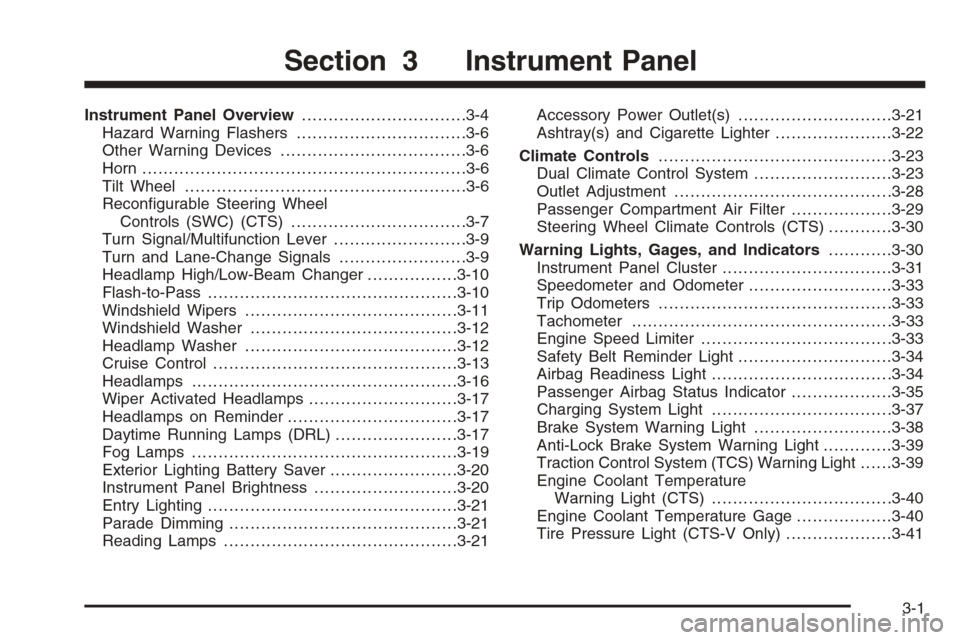
Instrument Panel Overview...............................3-4
Hazard Warning Flashers................................3-6
Other Warning Devices...................................3-6
Horn .............................................................3-6
Tilt Wheel.....................................................3-6
Recon�gurable Steering Wheel
Controls (SWC) (CTS).................................3-7
Turn Signal/Multifunction Lever.........................3-9
Turn and Lane-Change Signals........................3-9
Headlamp High/Low-Beam Changer.................3-10
Flash-to-Pass...............................................3-10
Windshield Wipers........................................3-11
Windshield Washer.......................................3-12
Headlamp Washer........................................3-12
Cruise Control..............................................3-13
Headlamps..................................................3-16
Wiper Activated Headlamps............................3-17
Headlamps on Reminder................................3-17
Daytime Running Lamps (DRL).......................3-17
Fog Lamps ..................................................3-19
Exterior Lighting Battery Saver........................3-20
Instrument Panel Brightness...........................3-20
Entry Lighting...............................................3-21
Parade Dimming...........................................3-21
Reading Lamps............................................3-21Accessory Power Outlet(s).............................3-21
Ashtray(s) and Cigarette Lighter......................3-22
Climate Controls............................................3-23
Dual Climate Control System..........................3-23
Outlet Adjustment.........................................3-28
Passenger Compartment Air Filter...................3-29
Steering Wheel Climate Controls (CTS)............3-30
Warning Lights, Gages, and Indicators............3-30
Instrument Panel Cluster................................3-31
Speedometer and Odometer...........................3-33
Trip Odometers............................................3-33
Tachometer.................................................3-33
Engine Speed Limiter....................................3-33
Safety Belt Reminder Light.............................3-34
Airbag Readiness Light..................................3-34
Passenger Airbag Status Indicator...................3-35
Charging System Light..................................3-37
Brake System Warning Light..........................3-38
Anti-Lock Brake System Warning Light.............3-39
Traction Control System (TCS) Warning Light......3-39
Engine Coolant Temperature
Warning Light (CTS)..................................3-40
Engine Coolant Temperature Gage..................3-40
Tire Pressure Light (CTS-V Only)....................3-41
Section 3 Instrument Panel
3-1
Page 132 of 442
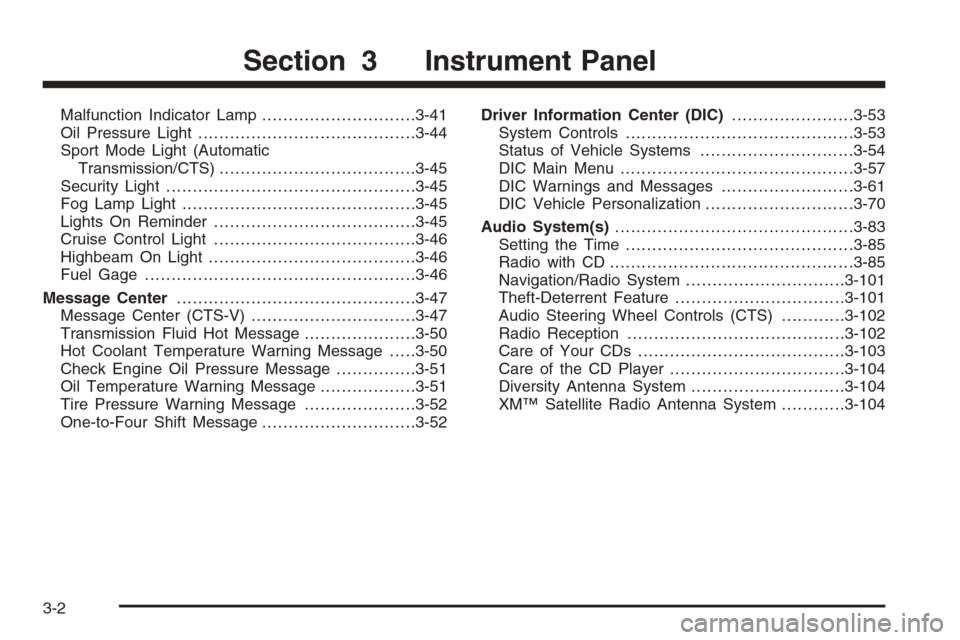
Malfunction Indicator Lamp.............................3-41
Oil Pressure Light.........................................3-44
Sport Mode Light (Automatic
Transmission/CTS).....................................3-45
Security Light...............................................3-45
Fog Lamp Light............................................3-45
Lights On Reminder......................................3-45
Cruise Control Light......................................3-46
Highbeam On Light.......................................3-46
Fuel Gage...................................................3-46
Message Center.............................................3-47
Message Center (CTS-V)...............................3-47
Transmission Fluid Hot Message.....................3-50
Hot Coolant Temperature Warning Message.....3-50
Check Engine Oil Pressure Message...............3-51
Oil Temperature Warning Message..................3-51
Tire Pressure Warning Message.....................3-52
One-to-Four Shift Message.............................3-52Driver Information Center (DIC).......................3-53
System Controls...........................................3-53
Status of Vehicle Systems.............................3-54
DIC Main Menu ............................................3-57
DIC Warnings and Messages.........................3-61
DIC Vehicle Personalization............................3-70
Audio System(s).............................................3-83
Setting the Time...........................................3-85
Radio with CD..............................................3-85
Navigation/Radio System..............................3-101
Theft-Deterrent Feature................................3-101
Audio Steering Wheel Controls (CTS)............3-102
Radio Reception.........................................3-102
Care of Your CDs.......................................3-103
Care of the CD Player.................................3-104
Diversity Antenna System.............................3-104
XM™ Satellite Radio Antenna System............3-104
Section 3 Instrument Panel
3-2
Page 170 of 442

If the TC warning light stays on or comes on while you
are driving, pull off the road as soon as possible
and stop carefully. Try resetting the system by turning
the ignition off then back on. If the light still stays
on or comes back on again while you are driving, your
vehicle needs service. Have the Traction Control
System (TCS) inspected as soon as possible. See
Traction Control System (TCS) (CTS) on page 4-9or
Traction Control System (TCS) (CTS-V) on page 4-10
for more information.
Engine Coolant Temperature
Warning Light (CTS)
This light will come on
when you �rst start the
vehicle as a check
to let you know that the
light is working.
It will go out after a few seconds. If the light does not
come on, see your dealer.If the light does not go out or if the light comes on and
stays on while you are driving, your vehicle may
have a problem with the cooling system. You should
stop the vehicle and turn off the engine as soon
as possible to avoid damage to the engine. A warning
chime will also sound when this light is on.
SeeEngine Overheating on page 5-28for more
information.
Engine Coolant Temperature Gage
This gage shows the
engine coolant
temperature. If the gage
pointer moves into
the shaded area, the
engine is too hot.
That reading means the same thing as the warning
light – the engine coolant is very hot. SeeEngine
Overheating on page 5-28.
3-40
Page 177 of 442
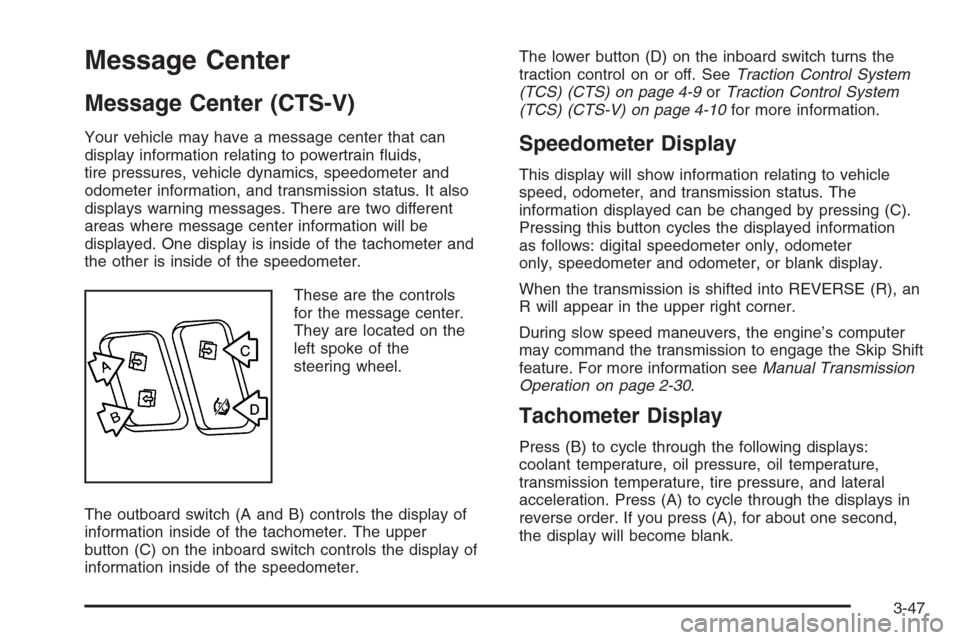
Message Center
Message Center (CTS-V)
Your vehicle may have a message center that can
display information relating to powertrain �uids,
tire pressures, vehicle dynamics, speedometer and
odometer information, and transmission status. It also
displays warning messages. There are two different
areas where message center information will be
displayed. One display is inside of the tachometer and
the other is inside of the speedometer.
These are the controls
for the message center.
They are located on the
left spoke of the
steering wheel.
The outboard switch (A and B) controls the display of
information inside of the tachometer. The upper
button (C) on the inboard switch controls the display of
information inside of the speedometer.The lower button (D) on the inboard switch turns the
traction control on or off. SeeTraction Control System
(TCS) (CTS) on page 4-9orTraction Control System
(TCS) (CTS-V) on page 4-10for more information.Speedometer Display
This display will show information relating to vehicle
speed, odometer, and transmission status. The
information displayed can be changed by pressing (C).
Pressing this button cycles the displayed information
as follows: digital speedometer only, odometer
only, speedometer and odometer, or blank display.
When the transmission is shifted into REVERSE (R), an
R will appear in the upper right corner.
During slow speed maneuvers, the engine’s computer
may command the transmission to engage the Skip Shift
feature. For more information seeManual Transmission
Operation on page 2-30.
Tachometer Display
Press (B) to cycle through the following displays:
coolant temperature, oil pressure, oil temperature,
transmission temperature, tire pressure, and lateral
acceleration. Press (A) to cycle through the displays in
reverse order. If you press (A), for about one second,
the display will become blank.
3-47
Page 178 of 442

Coolant Temperature
When the coolant
temperature displays you
will see the coolant
temperature symbol.
The temperature displays in degrees Fahrenheit or
Celsius with a graph beneath the reading. If the graph
shows the temperature in the shaded area all the way on
the right, then the coolant temperature is hot. See
Engine Overheating on page 5-28for more information.
Oil Pressure
When the oil pressure
displays you will see the
oil pressure symbol.The oil pressure displays in psi or kPa with a graph
beneath the reading. If the graph shows the pressure in
the shaded area all the way to the left, then the oil
pressure is low. SeeEngine Oil on page 5-16and
DIC Warnings and Messages on page 3-61for more
information.
Oil Temperature
When the oil temperature
displays you will see the
oil temperature symbol.
The temperature displays in degrees Fahrenheit or
Celsius with a graph beneath the reading. If the graph
shows the temperature in the shaded area all the way on
the right, then the oil temperature is hot. SeeEngine
Oil on page 5-16for more information.
3-48
Page 180 of 442
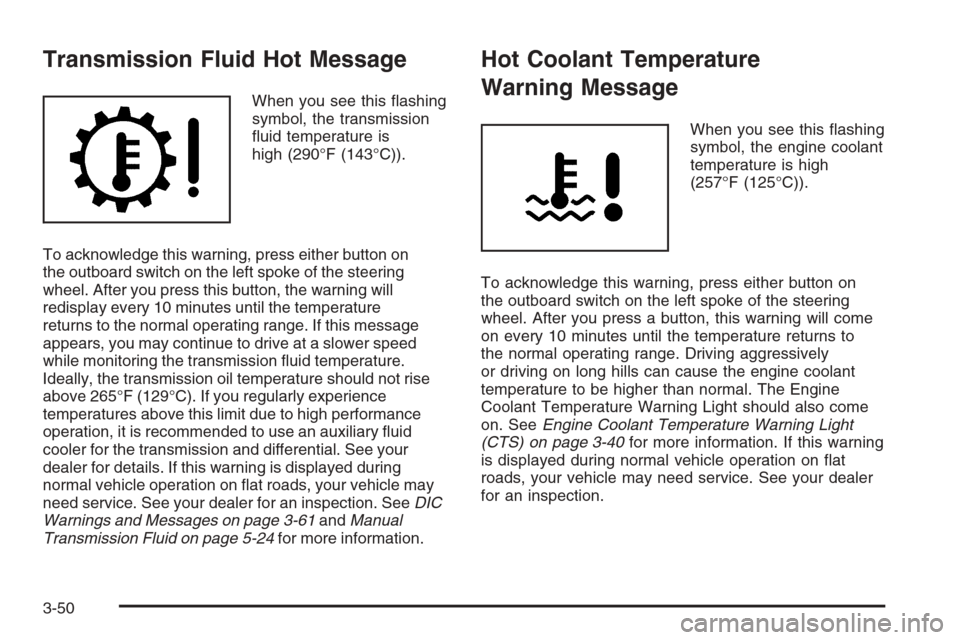
Transmission Fluid Hot Message
When you see this �ashing
symbol, the transmission
�uid temperature is
high (290°F (143°C)).
To acknowledge this warning, press either button on
the outboard switch on the left spoke of the steering
wheel. After you press this button, the warning will
redisplay every 10 minutes until the temperature
returns to the normal operating range. If this message
appears, you may continue to drive at a slower speed
while monitoring the transmission �uid temperature.
Ideally, the transmission oil temperature should not rise
above 265°F (129°C). If you regularly experience
temperatures above this limit due to high performance
operation, it is recommended to use an auxiliary �uid
cooler for the transmission and differential. See your
dealer for details. If this warning is displayed during
normal vehicle operation on �at roads, your vehicle may
need service. See your dealer for an inspection. SeeDIC
Warnings and Messages on page 3-61andManual
Transmission Fluid on page 5-24for more information.
Hot Coolant Temperature
Warning Message
When you see this �ashing
symbol, the engine coolant
temperature is high
(257°F (125°C)).
To acknowledge this warning, press either button on
the outboard switch on the left spoke of the steering
wheel. After you press a button, this warning will come
on every 10 minutes until the temperature returns to
the normal operating range. Driving aggressively
or driving on long hills can cause the engine coolant
temperature to be higher than normal. The Engine
Coolant Temperature Warning Light should also come
on. SeeEngine Coolant Temperature Warning Light
(CTS) on page 3-40for more information. If this warning
is displayed during normal vehicle operation on �at
roads, your vehicle may need service. See your dealer
for an inspection.
3-50
Page 182 of 442

Tire Pressure Warning Message
When you see this �ashing
symbol, one or more of the
vehicle’s tires is either
under or over-in�ated.
To acknowledge this warning, press either button on the
outboard switch on the left spoke of the steering
wheel. There are three levels of warning for this display:
1. High Tire Pressure (above 42 psi (290 kPa))
2. Low Tire Pressure (below 25 psi (170 kPa))
3. Flat Tire (below 5 psi (35 kPa))
For conditions 1 and 2, this warning will �ash �ve times
and the display will then show the tire pressure gage. For
condition 3, this warning will �ash continuously until the
driver acknowledges it. In any of the three cases, the
warning will redisplay every 10 minutes until the situation
is corrected. Conditions 2 and 3 will also display a
warning light elsewhere on the cluster that will stay on
after this warning is acknowledged. SeeTire Pressure
Light (CTS-V Only) on page 3-41for more information.
Also seeTire Pressure Monitor System on page 5-68for
more information on tire pressure speci�cations.
One-to-Four Shift Message
If equipped, this message
indicates that you can only
shift from FIRST (1) to
FOURTH (4) instead
of FIRST (1) to
SECOND (2).
You must complete the shift into FOURTH (4) to turn off
this feature. This helps you get the best possible fuel
economy.
After shifting to FOURTH (4), you may downshift to a
lower gear if you prefer.
Notice:Forcing the shift lever into any gear except
FOURTH (4) when the 1 TO 4 SHIFT light comes
on may damage the transmission. Shift only from
FIRST (1) to FOURTH (4) when the light comes on.
This message will come on when:
The engine coolant temperature is higher than
169°F (76°C),
you are going 15 to 19 mph (24 to 31 km/h) and
you are 21 percent throttle or less.
3-52